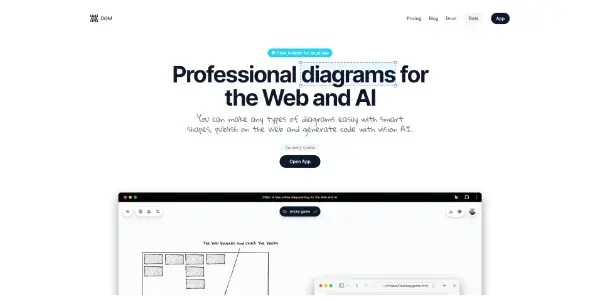DGM AI

Generate professional, automated diagrams using AI. Use pre-built libraries for UML, ERD, Flowchart, UI Wireframe, etc.
DGM AI: Revolutionizing Diagram Creation with AI
DGM AI is a free, AI-powered tool designed to automate the creation of professional-quality diagrams. It leverages artificial intelligence to simplify the often tedious and time-consuming process of diagramming, making it accessible to a broad range of users across various fields. This article explores its capabilities, applications, and how it stacks up against competitors.
What DGM AI Does
DGM AI streamlines diagram creation by leveraging AI to generate diagrams automatically. Users provide input, either through text descriptions or partial diagrams, and the AI interprets this information to produce a complete, polished diagram. This eliminates the need for manual drawing and ensures consistency in style and notation. The tool focuses on several key diagram types, utilizing pre-built libraries to guarantee accuracy and adherence to established standards.
Main Features and Benefits
- AI-Powered Automation: The core benefit lies in its ability to generate diagrams automatically, significantly reducing the time and effort required.
- Pre-built Libraries: DGM AI offers pre-built libraries for various diagram types, including:
- UML Diagrams: (e.g., Class Diagrams, Use Case Diagrams, Sequence Diagrams) facilitating software design and communication.
- ERD (Entity-Relationship Diagrams): Essential for database design and management.
- Flowcharts: For visualizing processes and workflows in diverse applications.
- UI Wireframes: Enabling rapid prototyping and iteration in user interface design.
- Multiple Output Formats: Export diagrams in various formats suitable for different purposes (e.g., PNG, SVG, PDF).
- Intuitive Interface: Designed for ease of use, even for individuals with limited diagramming experience.
- Free Access: The tool is available for free, making advanced diagramming capabilities accessible to everyone.
Use Cases and Applications
DGM AI finds application across multiple sectors:
Education/Studies:
- Students: Quickly create diagrams for assignments, presentations, and project reports across various subjects (computer science, engineering, business).
- Educators: Generate clear and concise diagrams for teaching materials and courseware.
Productivity:
- Software Developers: Design and document software systems efficiently using UML diagrams.
- Project Managers: Visualize project workflows and dependencies using flowcharts.
- Business Analysts: Create ERDs for database design and model business processes.
Research & Science:
- Researchers: Visualize complex data relationships and experimental processes.
- Scientists: Illustrate scientific concepts and models effectively.
Comparison to Similar Tools
While several tools offer diagram creation capabilities, DGM AI distinguishes itself through its AI-powered automation. Many competitors require manual drawing or offer limited automation features. DGM AI's free access is another significant advantage, making it a compelling alternative to paid software offering similar functionalities. Specific comparisons with other tools like Lucidchart, draw.io, and PlantUML would require a detailed feature-by-feature analysis, considering factors such as AI capabilities, library coverage, export options, and pricing models.
Pricing Information
DGM AI is currently offered completely free of charge. There are no subscription fees or hidden costs associated with its use.
Conclusion
DGM AI represents a significant advancement in diagram creation technology. Its AI-powered automation, comprehensive library of diagram types, and free access make it a valuable tool for students, professionals, and researchers alike. Its ease of use and versatility position it as a strong contender in the diagramming software market, and its future development promises even greater capabilities.